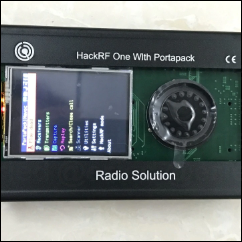-
-
Notifications
You must be signed in to change notification settings - Fork 610
First steps
There are basically two versions of the PortaPack. If you have one that looks like the one below, you have the H1.


The H2 is a slightly improved version, but the people making this copy never published the source, hence breaking the license terms. It looks like this:

The main difference are the controls and the screen, but the H2 usually has extra circuitry to manage the battery charging and powering on/off.
The original H1 powers instantly when you plug a power supply to the USB port. To turn it off, just unplug it. Similar to the issues with some USB cables while upgrading the firmware, the quality of your cable might affect the performance.
To power on/off the H2, you need to hold the middle button (knob or pushbutton) for few seconds.
This version can charge the internal lipo battery via the USB. There is a led indicator that turn off when the charging is done, but it might flicker.
A internal battery between 1000 and 2000 mAh should last a couple of hours of use, depending for how long you are transmitting. The standby consumption is very low, around 52 uA, so you do not need to worry to remove/disconnect the battery in normal circumstances.
Note
The wiki is incomplete. Please add content and collaborate.
Important
- This is a public wiki. Everything is visible to everyone. Don't use it for personal notes.
- Avoid linking to external tutorials/articles; they may become outdated or contain false information.
How to collaborate
How to ask questions correctly
- First steps
- Usage cautions
- Intended use and Legality
- Features
- PortaPack Versions (which one to buy)
- HackRF Versions
- Firmware update procedure
- Description of the hardware
- User interface
- Powering the PortaPack
-
Troubleshooting
- Won't boot
- Config Menu
- Firmware upgrade
- Diagnose firmware update in Windows
- Receive Quality Issues
- No TX/RX
- TX Carrier Only
- H2+ speaker modifications
- Dead Coin Cell Battery
- Factory Defaults
- SD card not recognized by PC with the SD-card over USB selected
- DFU overlay
- Full reset
- SolveBoard
- How to Format SDCard
- Applications
-
Compilation of the firmware
- Compile on WSL with ninja
- How to compile on Windows faster with WSL 2
- Using Docker and Kitematic
- Docker command-line reference
- Using Buddyworks and other CI platforms
- Notes for Buddy.Works (and other CI platforms)
- Using ARM on Debian host
- All in one script for ARM on Debian host
- Compile on Arch based distro (exclude Asahi)
- Dev build versions
- Notes About ccache
- Create a custom map
- Code formatting
- PR process
- Description of the Structure
- Software Dev Guides
- Tools
- Research
- UI Screenshots
- Maintaining
- Creating a prod/stable release (Maintainers only)
- Maintaining rules
- Development States Notes